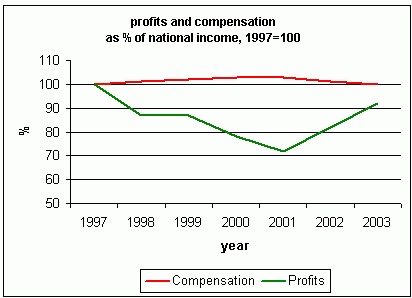Thursday, April 14, 2005
Profits versus pay -- always the one-way argument.
The New York Times reports with great concern on ...
Yet wait a minute ... back during the recent recession, as profits plummeted while employee compensation rose as a percentage of national income ...

... did Mr. Bernstein contribute to all the articles in the New York Times wondering how employees were able to extract such pay at the expense of profits at such a dire time?
Hey, did the New York Times write any such articles? ;-)
Which brings us to a second point -- to write this article the Times reporter needs to employ a little sleight of hand with the Bureau of Labor Statistics data cited, which 9 of 10 readers of the story will never catch, although it is the only thing that makes the story line "falling fortunes of wage earners" possible.
Namely, the "wages" that are cited as "falling" are only a portion of pay -- they exclude benefits. And, of course, in our world benefits are becoming a larger portion of total pay every year.
Including benefits, what employers actually paid -- total employee compensation -- in real dollars rose yet again last year, reports the BLS.
So much for the story lead about employees being paid less for the first time in a decade.
Of course...
One curious thing about this Times story is that Prof. Brad DeLong contributed to it, reinforcing the main theme...
Yet here he had the chance to himself improve the Times' reporting in two ways, by saying:
(1) "You know, employee pay actually rose last year, contrary to the impression you are giving"; and
(2) "Profits fell so far relative to pay during the last several years, especially during the recession -- employee compensation actually rose 2.5% during 2001 recession year itself! -- that a comparably sustained period of strong profitability might plausibly be expected to be necessary before businesses recover to where they were before the recession, and feel they can once more afford to bid as aggressively to drive up wages as they did then. "
But he didn't. Go figure.
Let him complain no more.
The New York Times reports with great concern on ...
The Falling Fortunes of Wage EarnersAnd, of course, this is due to corporations profiting at the expense of workers...
Even though the economy added 2.2 million jobs in 2004 and produced strong growth in corporate profits, wages for the average worker fell for the year, after adjusting for inflation.
"The question is not whether corporations are seeking higher profits; the question is how come they're getting them to such a degree at the expense of compensation," said Jared Bernstein, an economist with the Economic Policy Institute.Ah, so pay and profits are supposed to move in tandem, or else something is wrong -- and business is presumed to be acting "at the expense" of labor.
Yet wait a minute ... back during the recent recession, as profits plummeted while employee compensation rose as a percentage of national income ...

... did Mr. Bernstein contribute to all the articles in the New York Times wondering how employees were able to extract such pay at the expense of profits at such a dire time?
Hey, did the New York Times write any such articles? ;-)
Which brings us to a second point -- to write this article the Times reporter needs to employ a little sleight of hand with the Bureau of Labor Statistics data cited, which 9 of 10 readers of the story will never catch, although it is the only thing that makes the story line "falling fortunes of wage earners" possible.
Namely, the "wages" that are cited as "falling" are only a portion of pay -- they exclude benefits. And, of course, in our world benefits are becoming a larger portion of total pay every year.
Including benefits, what employers actually paid -- total employee compensation -- in real dollars rose yet again last year, reports the BLS.
So much for the story lead about employees being paid less for the first time in a decade.
Of course...
"Employee Fortunes Continue to Rise -- Benefits Increase Over Past Two Years at the Fastest Pace On Record"... just wouldn't be a story with the same attraction, so we can see why using the selective data is necessary.
One curious thing about this Times story is that Prof. Brad DeLong contributed to it, reinforcing the main theme...
Now on his own blog Prof. DeLong has lamented "Why can't we have a better press corps?", oh, hundreds of times -- not infrequently about the NY Times in particular.J. Bradford DeLong, an economist at the University of California, Berkeley, said that current wage patterns, while perhaps only temporary, did not conform to traditional economic explanations.
"You'd think that with the unemployment rate near 5 percent and productivity growth so strong, employers would be anxious to raise payrolls and would have plenty of headroom to raise wages," he said. "But they're not."
Yet here he had the chance to himself improve the Times' reporting in two ways, by saying:
(1) "You know, employee pay actually rose last year, contrary to the impression you are giving"; and
(2) "Profits fell so far relative to pay during the last several years, especially during the recession -- employee compensation actually rose 2.5% during 2001 recession year itself! -- that a comparably sustained period of strong profitability might plausibly be expected to be necessary before businesses recover to where they were before the recession, and feel they can once more afford to bid as aggressively to drive up wages as they did then. "
But he didn't. Go figure.
Let him complain no more.
